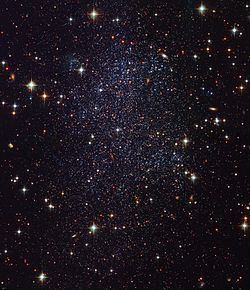Right ascension 19 29 59.0 Redshift -79 ± 1 km/s Magnitude 15.5 Apparent magnitude (V) 15.5 | Declination −17° 40′ 41″ Apparent size (V) 2′.9 × 2′.1 | |
 | ||
Distance 3.39 ± 0.23 Mly (1.04 ± 0.07 Mpc) Type IB(s)m V (Dwarf irregular galaxy) Similar Aquarius Dwarf, Sagittarius Dwarf Spheroid, Sextans B, Pisces Dwarf, Wolf–Lundmark–Melotte | ||
The Sagittarius Dwarf Irregular Galaxy or SagDIG is a dwarf galaxy in the constellation of Sagittarius. It lies about 3.4 million light-years away. SagDIG should not be confused with the Sagittarius Dwarf Elliptical Galaxy or SagDEG, a satellite galaxy of the Milky Way. It was discovered by Cesarsky et al. on a photographic plate taken for the ESO (B) Atlas on June 13, 1977 using the ESO 1 meter Schmidt telescope.
The SagDIG is thought to be the member of the Local Group most remote from the Local Group’s barycenter. It is only slightly outside the zero-velocity surface of the Local Group.
SagDIG is a much more luminous galaxy than Aquarius Dwarf and it has been through a prolonged star formation This has resulted in it containing a rich intermediate-age population of stars. Twenty-seven candidate carbon stars have been identified inside SagDIG. Analysis shows that the underlying stellar population of SagDIG is metal-poor (at least [Fe/H] ≤ −1.3). Further, the population is young, with the most likely average age between 4 and 8 billion years for the dominant population.
